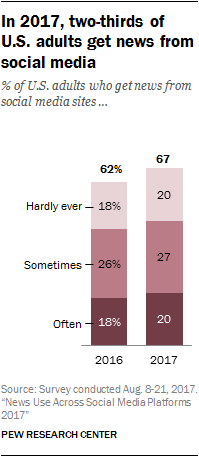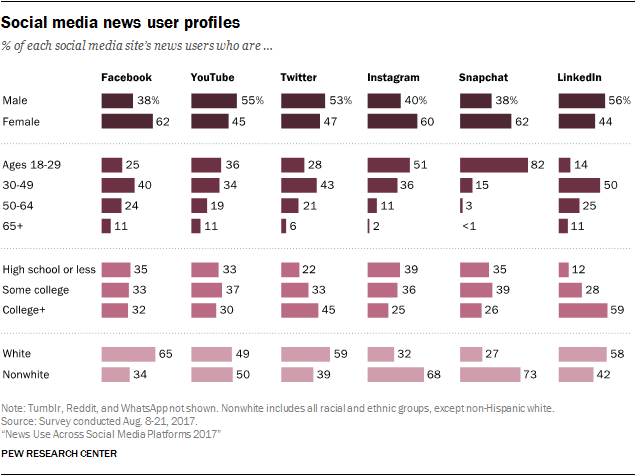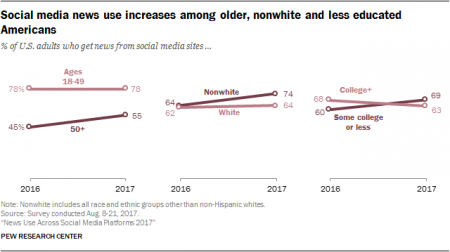
2 in 3 Americans get news via social media, according to News Use Across Social Media Platforms 2017 from the Pew Research Center. One in 5 people get news “often” from social media, shown in the first chart.
The growth of people accessing news via social media, overall, hasn’t dramatically grown in the year since 2016. But underneath that fairly flat trend is some important movement to note by demographic cohort, which has implications for health/healthcare marketing:
- 55% of people 50 and over are social media news consumers (8 in 10 people under 50 are)
- Nonwhites are more likely than whites to use social media for news, and
- More people will some college of less get news via social media compared with college graduates.
By site, among social networks used for news, Twitter has grown fastest as a news source 2017. But Facebook is still the biggest draw for news versus YouTube, Twitter, Instagram, Snapchat, LinkedIn, Reddit, and WhatsApp. Note that 66% (that’s 2 in 3 American adults) uses Facebook these days, with nearly one-half of American adults getting news on the site.
 The demographics of social media news consumers are important to tease out – again, useful for tailoring healthcare marketing messages, whether for public health or for commercial purposes.
The demographics of social media news consumers are important to tease out – again, useful for tailoring healthcare marketing messages, whether for public health or for commercial purposes.
The second chart illustrates social media news use by demographic cohort and network. What’s especially notable here is the “nonwhite” vs. “white” segment comparisons: Instagram and Snapchat are, dramatically, more used by nonwhites than whites. But Facebook, LinkedIn and Twitter are much more popular with whites than nonwhites.
Of course, Snapchat is vastly more used for news by the youngest adult cohort, 18 to 29 years of age, than any other age group by huge margins. LinkedIn is much more used for news by whites, college grads, men, and people ages 30-49.
 Finally, check out the third chart which shows that Americans who use news websites and apps, by far, consuming more news “everywhere” on social media than Americans who look for news on TV, via radio or in print newspapers. Among all media, local TV garners the largest share of news “eyeballs” even over all news websites and apps, by a factor of 37% versus 33%.
Finally, check out the third chart which shows that Americans who use news websites and apps, by far, consuming more news “everywhere” on social media than Americans who look for news on TV, via radio or in print newspapers. Among all media, local TV garners the largest share of news “eyeballs” even over all news websites and apps, by a factor of 37% versus 33%.
Pew Research Center polled 4,971 U.S. adults in August 2017 for this survey.
Health Populi’s Hot Points: To adapt a favorite and informative riff from the Robert Wood Johnson Foundation, health is where we live, work, play, pray…and seek information.
The Pew data informs us that people of color tend to use certain social media channels for news than white people do: in particular, Snapchat and Instagram, followed by YouTube.
This distinction is important for health message makers to consider. Whether you’re a public health or patient advocate, or a drug company developing a direct-to-consumer campaign to bolster medication adherence for, say, Type 2 Diabetes, it’s crucial to know “where” people go for trusted information. If a strategy is being developed to boost understanding about nutrition, diabetes and exercise among Latinos, then distributing content via Instagram for recipes and engaging infographics (in Spanish, perhaps) should be evaluated vs. a print news program. These aren’t mutually exclusive, but used for rationalizing resource-allocation decisions across media types.
Not all social media are created equal when it comes to peoples’ news consumption. Digging deeper into consumers’ trusted information sources is key for health care marketers looking for effective health care communications and, ultimately, patient outcomes.





 Interviewed live on BNN Bloomberg (Canada) on the market for GLP-1 drugs for weight loss and their impact on both the health care system and consumer goods and services -- notably, food, nutrition, retail health, gyms, and other sectors.
Interviewed live on BNN Bloomberg (Canada) on the market for GLP-1 drugs for weight loss and their impact on both the health care system and consumer goods and services -- notably, food, nutrition, retail health, gyms, and other sectors. Thank you, Feedspot, for
Thank you, Feedspot, for  As you may know, I have been splitting work- and living-time between the U.S. and the E.U., most recently living in and working from Brussels. In the month of September 2024, I'll be splitting time between London and other parts of the U.K., and Italy where I'll be working with clients on consumer health, self-care and home care focused on food-as-medicine, digital health, business and scenario planning for the future...
As you may know, I have been splitting work- and living-time between the U.S. and the E.U., most recently living in and working from Brussels. In the month of September 2024, I'll be splitting time between London and other parts of the U.K., and Italy where I'll be working with clients on consumer health, self-care and home care focused on food-as-medicine, digital health, business and scenario planning for the future...